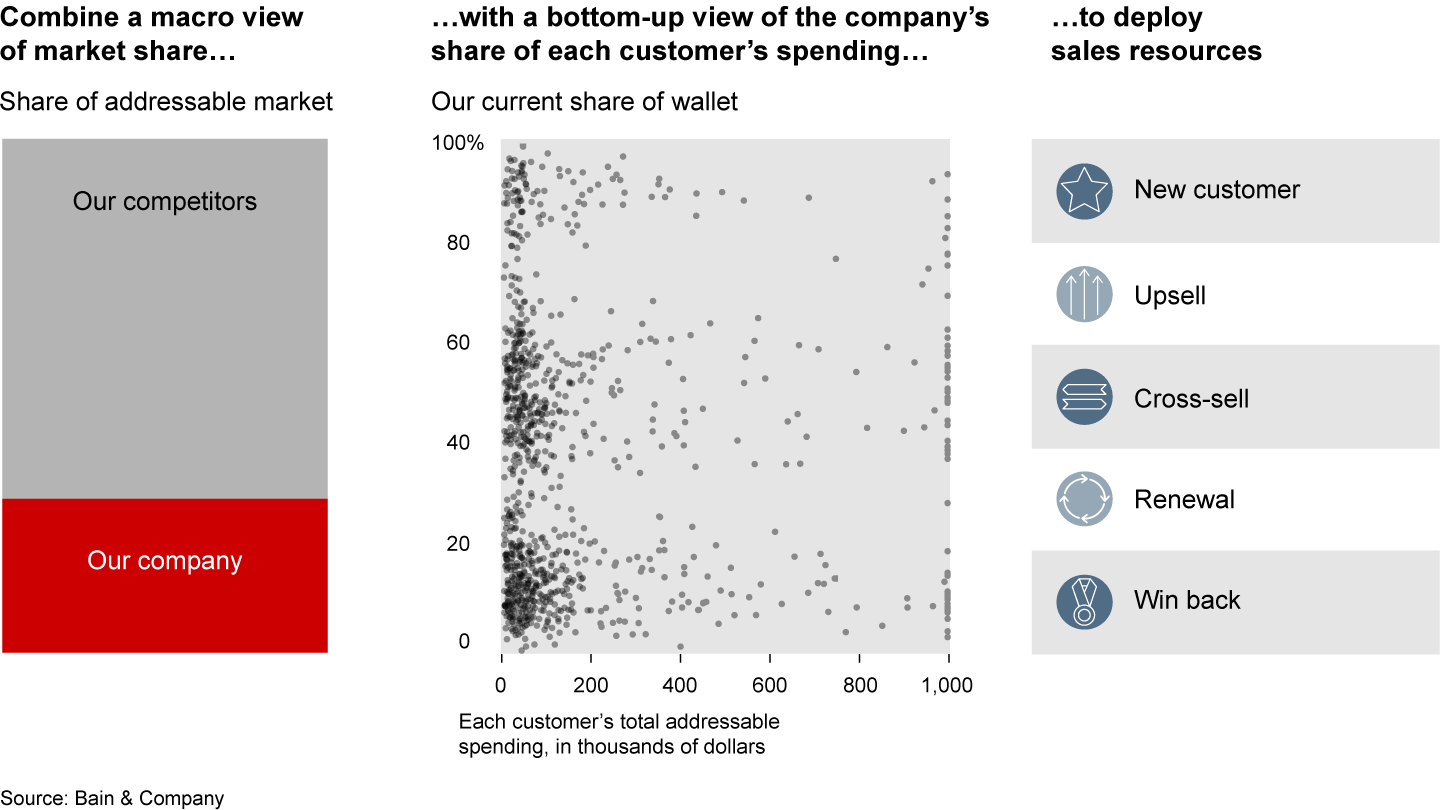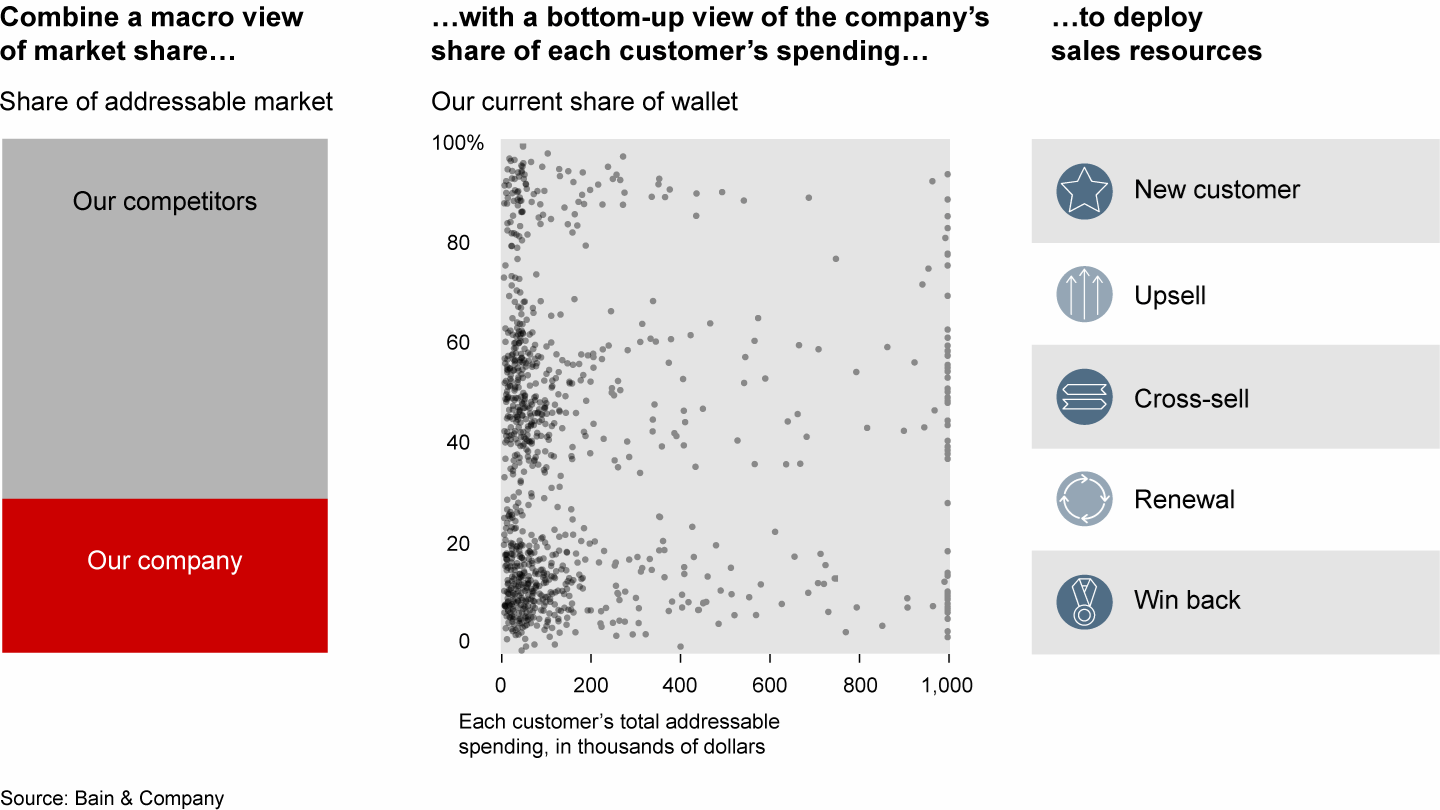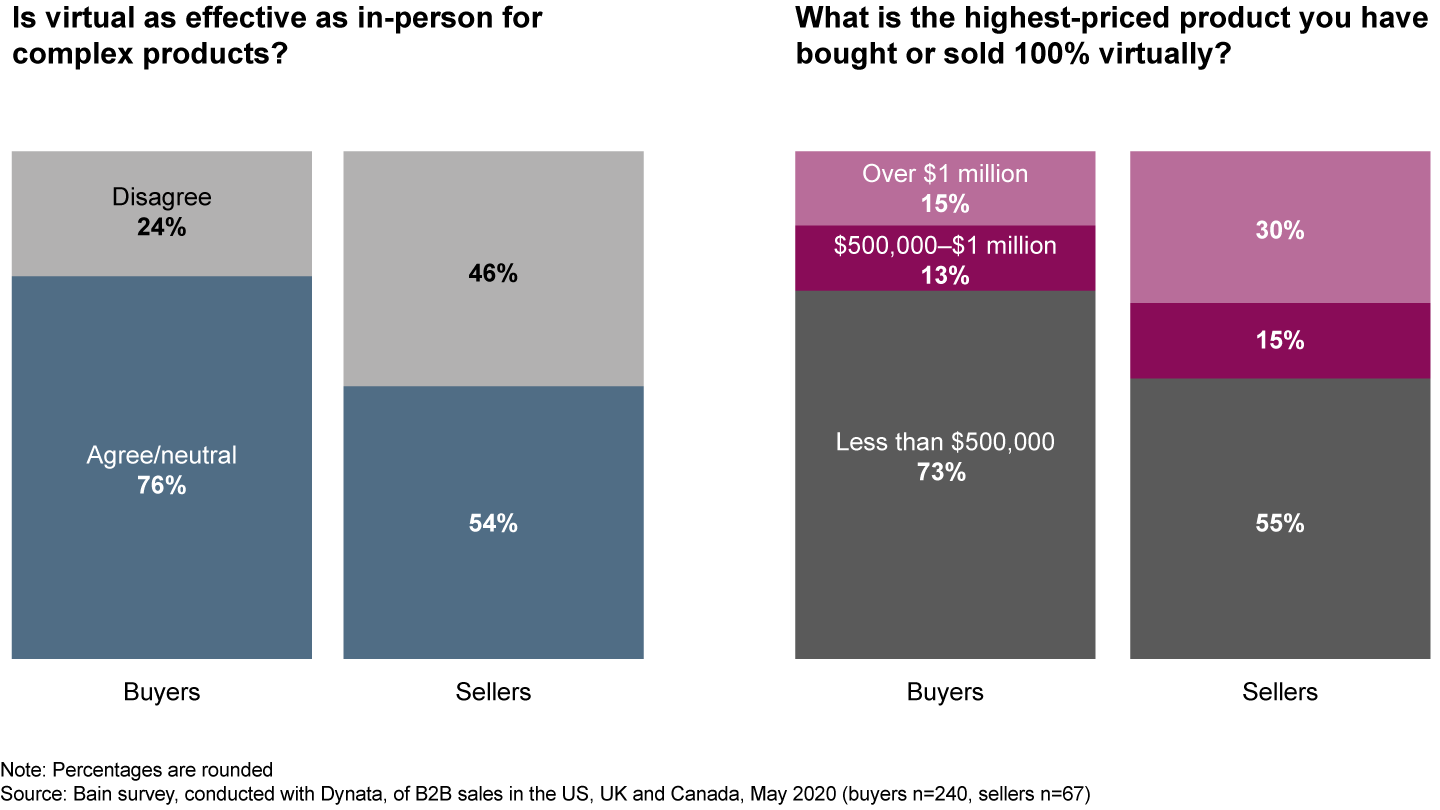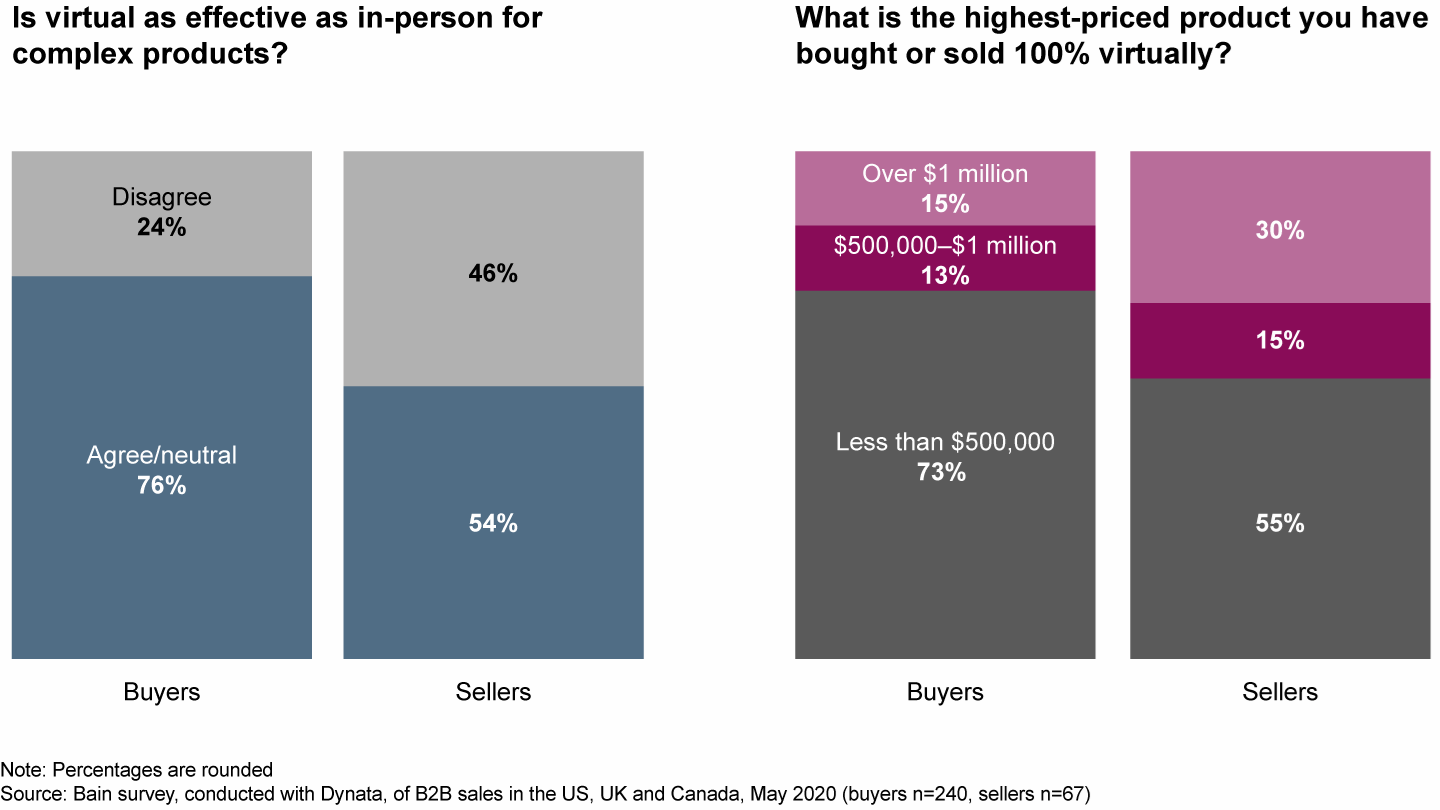Report

This article is Chapter 12 of Bain’s global Technology Report 2020. Explore the contents of the report here or download the PDF to read the full report.
Covid-19 has profoundly affected the sales and marketing organizations of technology companies. Every sales representative became a remote, virtual seller overnight, just as the normal stream of customer requests went haywire.
Some software-as-a-service (SaaS) providers, for example, fielded requests from up to one-third of their customers to skip payments or extend terms. Renewals in software and managed-services businesses suddenly experienced higher levels of risk. Decision making within many buyer organizations seized up for a while, which stalled activity for frontline reps. As a result, productivity took a hit among many sellers. Those fortunate to be in markets where demand spiked had to learn new motions to enable virtual selling and create surge capacity.
With so many people still working from home, the pandemic highlights two capabilities that have gained importance over the past few years and are poised to continue: prescriptive sales playbooks and virtual selling—even for complex buying cycles. While many technology executives recognize these capabilities can boost revenues, misconceptions about both abound and prevent companies from using them to full advantage.
Come in and play
Many technology companies believe they run sales plays, but few reap the full potential value from this approach, because it requires rigorous, consistent execution. A sales play consists of a prescriptive, coordinated set of sales and marketing actions orchestrated to create and then win an opportunity with a specific customer or prospect. For example, a cross-sell play could target customers who have a specific product configuration with a managed-service offering.
Each play can specify up to 20 elements to support execution, including the activities of each role on the sales team, marketing messages, promotional pricing, customer testimonials, call scripts and key performance indicators. This level of specificity, in our experience, raises the odds of success on each play.
In the early weeks of the pandemic, an information management provider created a detailed sales play for its offering of a digital mail room, which had gained a new relevance in the market. This play has spurred nearly $30 million of opportunities in the pipeline at a time when customers had frozen their decisions on many of the company’s other offerings.
The most sophisticated organizations have moved beyond plays that simply include sales collateral and steps to orchestrate an account team. They’re building a full-fledged capability with the play serving as the linchpin of a go-to-market system behind everything from marketing campaigns to coaching to pipeline reviews. Based on our work with technology companies, those that reap the most value from sales plays share a few characteristics that other companies can cultivate to their advantage:
Money map. Effective selling organizations maintain a map of how much each customer spends across major categories in their product portfolio (see Figure 1). This allows providers to quantify where and how much customers can increase spending in these categories, as well as potential spending by prospects. A map of spending by individual customer and category is far more useful than a rough sense of market size. Such a map helped one fiber technology company more than double the size of its addressable market, by evaluating how much each current and prospective customer could spend in each category.


Win room. Companies that get a return from sales plays invest in a clearinghouse to orchestrate and track play execution. A cross-functional team in the win room takes the money map analysis, adds the latest intelligence from field reps, rapidly reorients sales capacity to critical areas, and measures how effectively each play has expanded the pipeline and converted opportunities into closed deals.
The team also ranks the backlog of sales plays, and prompts sales support resources to develop market-ready plays. The plays themselves are developed in a sales play “factory” by teams typically composed of subject-matter experts from product management, marketing, sales enablement and frontline reps.
One infrastructure software provider relied on a money map and a win room to improve customer renewals. The team was able to identify high-priority, at-risk renewals. This new approach led to the immediate retention of more than $5 million of accounts previously deemed lost, putting the company on a path to improve renewal rates by 15 percentage points.
One-on-one. A third attribute of companies that excel in play-based selling is the discipline they bring to frontline management and coaching. They rigorously track play deployment, progress and performance. And they take full advantage of weekly one-on-one meetings between sales managers and reps to steer the execution of plays.
Our recent survey of 260 sales reps in the US, Canada and the UK finds that reps at companies that sustainably grow revenue and market share are 50% more likely than lagging firms to have a consistent weekly meeting with their manager. Reps that get the most value from these meetings report that their managers spend more time on deal strategy and coaching. By contrast, those at lagging firms said their managers focus on process and administrative topics. In the current moment of great uncertainty, there is a premium on clear, practical guidance to the front line, which prescriptive sales plays can provide.
We’re all virtual now
Covid-19 instantly accelerated a longer-term trend of B2B companies shifting their sales capacity from field-based to virtual models. Sometimes unwittingly, companies are discovering the advantages of virtual selling. It can provide customers with a better experience, with self-serve options for simple interactions, on-demand support or ready access to expertise. Virtual channels, whether for leads or end-to-end sales, raise productivity and lower selling costs. And win rates rise and sales cycles shorten with well-orchestrated virtual channels.
A recent survey, conducted with Dynata, of more than 300 B2B buyers and sellers in the US, UK and Canada found that half of sales transactions already were taking place virtually before the pandemic. The reason: Many buyers believe virtual channels are just as effective as face-to-face for large, complex purchases (see Figure 2).


Indeed, more than one-fourth of buyer respondents have virtually purchased products priced over $500,000. Moreover, most buyers and sellers expect a sustained increase in virtual interactions. In Bain’s recent survey of 153 software buyers in Europe and the US, 54% said they prefer all-virtual purchases, with another 37% preferring largely virtual with select on-site visits.
One telecommunications provider, for example, has migrated important aspects of its B2B sales to virtual channels, using marketing automation to create leads and installing an online self-service portal. After the first year of this migration, the new model increased revenues by 5% and reduced selling, general and administrative costs by 10%, at the same level of customer service. It cut the time to deliver a quote from days to minutes, all while sharply improving the company’s overall customer loyalty score.
A global technology company has seen more customer interactions during the pandemic and plans to keep a sizable share of sales operating virtually. Much of its field force will employ virtual selling practices between one-quarter to three-quarters of the time, depending on the nature of the role and opportunity. The company is investing in new digital tools, upgrading its digital purchase experience and introducing new recruiting and training methods.
Getting virtual sales right involves far more than using digital tools. You have to deploy the right people and other resources through the right channels at different points in the buying process. This implies that you understand the experience and information your customers need at each step, which channel they want to engage in, and how to provide the best support. It also requires the right operating model, with the right roles, metrics, sales motions, talent strategy, experience sharing and location strategy. Ultimately, the tech company mentioned above anticipates a marked improvement in sales productivity through greater use of virtual.
Granted, building a successful virtual sales engine hinges on winning over a sometimes skeptical sales team. In our recent survey, 55% of respondents said field reps would be demoralized or quit if asked to change to a primarily virtual model, while only 25% said they would be excited. Fortunately, reps and managers have a rich set of tools available, including voice analytics that can enable virtual coaching to platforms that can get the right collateral in front of the right sellers and customers.
What cannot be sold virtually?
Commercial executives can scope out an effective virtual sales engine by answering a set of questions:
- Where should we focus—which products, customer segments and steps of the “discover, try, buy, expand, renew” sequence?
- Which roles, metrics and processes should be standardized across regions? What skills are required?
- What is our digital hub strategy and how does it relate to the rest of the organization?
- What technology infrastructure and digital tools will best enable our mission?
- How should we stage our remix of direct channels and foster the required changes in behavior?
- What are the major risks that could slow or derail our effort?
The salient question overall now becomes, what cannot be sold virtually? For a major new prospective account, or a complex sales cycle with multiple influencers, it may still be important to hold a collaborative workshop on-site at critical points. But as the recovery from the pandemic and economic recession keeps getting pushed back, commercial leaders in technology companies should assume that everything can be sold virtually, then design a model that accommodates the specific opportunities that demand a face-to-face visit during the process. Combining virtual selling with a strong sales playbook will allow companies to adapt and keep generating revenues no matter what twists and turns lie ahead.